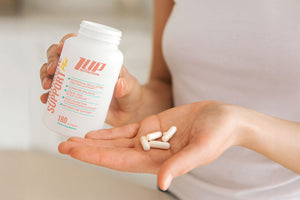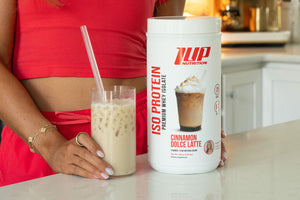At its core, weight loss is pretty simple -- you need to eat fewer calories than you burn each day.
Do this consistently, and regardless of what foods you eat or which diet you follow, you will lose weight.
This is because losing weight is primarily a function of calories in vs calories out.
Despite the simplicity of weight loss, many individuals still struggle to consume fewer calories than they should, which subsequently prevents them from losing weight.
That’s where this guide comes in.
Up next, we’ve compiled a cornucopia of tips to help you cut calories and lose weight fast!
Let’s get started!
10 Ways to Cut Calories
Track Calories and/or Macros
In order to know how many calories you need to cut from your diet in order to start losing weight, you first need to know how many calories you’re currently eating.
The only reliable way to do this is to write down what you eat each day (as well as how much of it you eat) and calculate the total number of calories.
This is your maintenance calories -- the number of calories you eat that maintains your body weight.
From there it’s a matter of simple arithmetic.
Since one pound of fat contains roughly 3500 calories, you need to a weekly deficit of 3500 calories, which comes out to a daily deficit of 500 calories.
What this means is that if you normally maintain your body weight eating 2500 calories per day, you would need to start eating 2000 calories per day to lose one pound each week.
With knowledge comes power, and when you know how many calories you need to eat to lose weight, you start off your weight loss journey with a tremendous amount of power.
And, if you need help figuring out how many calories do I need to eat to lose weight, click here.
Eliminate Calorie-Containing Drinks
Liquid calories are one of the under-the-radar contributors to stalled fat loss and unexpected weight gain.
Did you realize that your average 16oz serving of soda contains upwards of 200 calories and 44 grams of sugar?!
What’s more troubling is that many people are under the impression that liquid calories don’t impact weight loss.
If you consume 2-3 servings of soda per day, that’s easily an extra 400-600 calories of pure sugar you’re consuming, and not even realizing it.
Besides that, research also notes that calorie-containing beverages have a lower satiety index than whole foods of comparable calorie contents, and they may actually leave you hungrier.[1]
The takeaway here is that if you’re interested in losing weight, you need to limit your intake of calorie-containing liquids. This includes all manner of regular soda, fruit smoothies, juices, and alcohol.
When you’re dieting, calories are at a premium. You need to be focusing on foods that convey a high degree of satiety, and liquid calories clearly don’t fit under that umbrella.
Cook for Yourself
Meal prep services are all the rage these days.
And, while these food services list calorie and macronutrient contents on each serving, the simple truth of the matter is that unless you prepare the food yourself, you really have no way of knowing if what’s listed on the package is what’s actually in the package.
Look, we get it, everyone’s time is limited, and finding time to prep, cook, and eat all of your meals can be time-consuming.
But, the reality is, that if you’re serious about figuring out how to cut calories and lose weight fast, you should be cooking as much of your own food as possible.
By cooking your own food, you know exactly what goes into all of your meals, and you’ll have a much closer approximation as to the actual amount of calories each meal contains.
If you need help figuring out how to meal prep in a time-efficient manner, click here.
Drink Water Before Eating
Survey data indicates that as much as 75% of the population doesn’t drink enough water each day.[2]
Drinking water before a meal may help reduce the number of calories you eat at mealtime.[3,4]
The reason for this is that drinking comparable amounts of water before eating (1-2 cups) helps stretch the stomach, which helps signal the brain that fullness has been reached.
This helps you stop eating sooner and thus less likely to overeat.
Get Dressings & Sauces on the Side
Restaurant food is notoriously high in calories, usually due to a mix of the cooking methods involved (frying vs baking or roasting) and excessive “drizzles” of sauces and dressings.
Unbeknownst to you, these tasty sauces and dressings are laden with calories -- mostly from a combination of sugar and fat.
One of the biggest tips you can keep in mind when dining out is to always ask for sauces and dressings on the side. This will literally save you hundreds of calories on your meal.
Opt for Baked/Grilled Over Fried
Building off our previous point, another reason food at restaurants tastes so darn good is that it’s usually cooked in a lot of oil (i.e. deep-fried).
And while frying food makes it highly palatable, it also makes it highly caloric. The breading is nothing but highly refined carbohydrates (i.e. white flour) dipped in a bath of hot oil (fat).
This adds hundreds and hundreds of calories to your meal.
Most restaurants are willing to make accommodations, and if they need a little “coaxing” just mention to the waiter that you’re willing to tip (generously) for obliging. As such, if an entree comes with fried food, ask if you can have a grilled alternative.
Load Up on Non-Starchy Vegetables
In certain circles these days, carbohydrates are a four-letter word. Yet, carbohydrates are some of the most nutritionally-dense foods on the planet, particularly those of the non-starchy variety.
Not only are non-starchy vegetables (kale, spinach, broccoli, squash, etc.) rich in micronutrients (which are needed for optimal performance in the gym), they’re also low in calories, high in fiber, and very filling.
When figuring out how to cut calories, one of our favorite strategies is to fill half of your plate with non-starchy veggies. The remaining half can be filled with an equal amount of protein and starchy carbohydrates.
Utilizing this 50-25-25 approach helps ensure you’re feeling full after your meals (even while cutting calories) as well as getting in enough protein and starchy carbohydrates to fuel performance and support muscle recovery.
Tap & Snap
Your metabolic rate is made up of four key components:
- Basal Metabolic Rate (BMR) -- the number of calories your body burns at rest
- Thermic Effect of Food (TEF) -- the number of calories your body burns digesting and absorbing nutrients from the food you eat
- Thermic Effect of Activity (TEA) -- the number of calories you burn during organized physical activity (i.e. exercise)
- Non-Exercise Activity Thermogenesis (NEAT) -- the number of calories burned performed non-exercise activities (snapping your fingers, walking to get the mail, tapping your toes)
For those looking to increase their energy expenditure without having to commit more hours to the gym each week, increasing your non-exercise activity is a great way to increase the number of calories you burn each day without having to do more “exercise.”
Everything from tapping your foot to clicking a pen burns calories (albeit a small amount), but for those looking for any and every way to increase calorie burning, increasing NEAT is an easy way to achieve that goal.
Make Healthy Swaps
Look, we all love starchy, carby foods like pizza, pasta, and panini. And while those foods taste good, they’re also laden with calories.
Instead of bearing the full brunt of those dishes caloric burdens, you can prepare some equally delicious, lower-calorie substitutions right on your very own.
Instead of a flour crust for pizza, try a cauliflower crust or a low-calorie flatbread on the grill.
Instead of regular white flour pasta, consider using zucchini noodles or spaghetti squash.
And, instead of bread for your sandwich, try using lettuce wraps or slices of grilled eggplant.
These lower-calorie substitutions replace high-calorie, low micronutrient foods with low-calorie, high micronutrient dense foods that help fill you up without filling you out.
Try Intermittent Fasting
Intermittent Fasting is all the rage these days.
It can be done in a number of ways, but essentially it involves going for prolonged periods of time (12-16+ hours) without food, which means you have a relatively small window in which you are allowed to eat.
Now, the upside to intermittent fasting is that no foods are off-limits, which flies counter to many of the popular fad diets of today (keto, carnivore, paleo, etc.).
The potential “downside” is that if you’re accustomed to eating breakfast, it may take a few days of adjusting to get the feel of it.
Research has shown that intermittent fasting is effective for weight loss since it makes it easier to reduce the number of calories you eat during the day.[5]
Furthermore, since you know that you’re only allowed to eat during a small window each day, it helps take the focus off of food during your fasting window. You have a defined time when you can eat, thereby freeing up your mind to focus on other things -- such as your work or training session.
Takeaway
Dieting is bound to come with its fair share of aches, pains, and hunger pangs. It’s natural human physiology -- our bodies get used to eating a certain amount of food and it wants to keep it that way.
Fortunately, figuring out how to cut calories isn’t all that complicated, and by incorporating the tips we’ve outlined how you can easily cut calories without feeling completely deprived each day during your transformation challenge.
References
- Shearrer GE, O'Reilly GA, Belcher BR, et al. The impact of sugar sweetened beverage intake on hunger and satiety in minority adolescents [published correction appears in Appetite. 2016 May 1;100:272]. Appetite. 2016;97:43–48. doi:10.1016/j.appet.2015.11.015
- Survey of 3003 Americans, Nutrition Information Center, New York Hospital-Cornell Medical Center (April 14, 1998).
- Wakisaka, S., Nagai, H., Mura, E., Matsumoto, T., Moritani, T., & Nagai, N. (2012). The effects of carbonated water upon gastric and cardiac activities and fullness in healthy young women. Journal of Nutritional Science and Vitaminology, 58(5), 333–338. https://doi.org/10.3177/jnsv.58.333
- Davy BM, Dennis EA, Dengo AL, Wilson KL, Davy KP. Water consumption reduces energy intake at a breakfast meal in obese older adults. J Am Diet Assoc. 2008;108(7):1236–1239. doi:10.1016/j.jada.2008.04.013
- Barnosky, A. R., Hoddy, K. K., Unterman, T. G., & Varady, K. A. (2014). Intermittent fasting vs daily calorie restriction for type 2 diabetes prevention: a review of human findings. Translational Research, 164(4), 302–311. https://doi.org/https://doi.org/10.1016/j.trsl.2014.05.013






